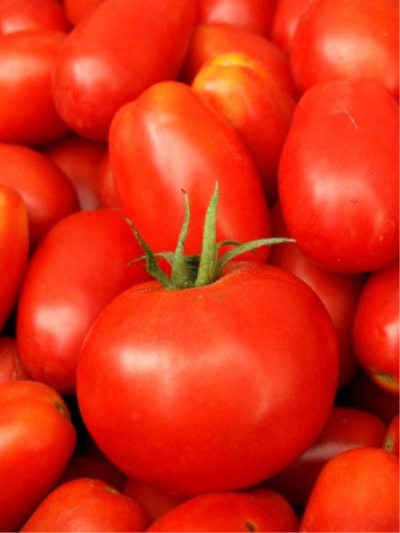
- Authors: Myazina L.A.
- Year of approval: 2002
- Category: grade
- Growth type: determinant
- Appointment: universal
- Ripening period: early
- Ripening time, days: 95-105
- Growing conditions: for open ground, for film greenhouses
- Bush height, cm: 120-140
- Foliage: strong
Such a pretentious name may raise concerns - whether the culture makes too high demands when growing. Of course, in skillful hands, problems will not arise. However, for this you should study the plant as thoroughly as possible.
Breeding history
The crown prince is actually a variety, not a hybrid. It has been allowed to be used in private gardens since 2002. The project for the breeding of such a tomato was entrusted to the famous breeder Myazina.
Description of the variety
The crown prince is characterized by a classic determinant development. This is a crop with universal application in the garden. The bushes grow up to 1.2-1.4 m. They are characterized by a large number of leaves. Large foliage is dark green in color.
The main qualities of the fruit
At the very beginning of development, the berries are light green in color. There is a dark green spot in the region of the stalk, but it is relatively small. As the ripeness progresses, the fruits will turn red. The mass of a single tomato is 200-250 g. Other details:
a flat-round shape is characteristic;
15-20 fruits will appear in the brush;
smooth and firm skin;
intermediate type of inflorescence;
laying of the first inflorescence above 6-7 leaves;
the formation of subsequent inflorescences with a step of 1 or 2 leaves;
articulated view of the stalk.
Taste characteristics
The bright scarlet flesh of this variety is quite juicy. The fruits of the crown prince are sweet. An attractive aroma is typical for them. A number of sources indicate the presence of a characteristic sour note.
Ripening and fruiting
Crown Prince is a classic early tomato. Between the discarding of the herbaceous greenery and the appearance of berries ready for picking, it takes from 95 to 105 days. Of course, in a particular year on a particular site, this can be very different. And ignoring the importance of leaving is also unacceptable.
Yield
Fee for 1 sq. m varies from 3.5 to 3.8 kg. Much depends, of course, on the weather situation and on the measures taken to take care of the plantings. Unofficial sources mention that the collection can reach 15-20 kg of berries per 1 sq. m.
The timing of planting seedlings and planting in the ground
You can sow seeds in containers in March or April. The specific choice will have to be made by the gardeners themselves. Readiness for planting in open ground is usually achieved at the age of 50-55 days. But here it is already necessary to individually assess the condition of each instance.

Growing tomato seedlings is an extremely important process, because it largely depends on whether the gardener will be able to harvest at all. All aspects must be taken into account, from seedbed preparation to planting in the ground.
Landing scheme
The distance between bushes in rows can vary from 40 to 50 cm. Usually 3 or 4 plants are planted on 1 "square". A denser planting, making care more difficult, can slightly increase overall productivity. But you should not get carried away with this, otherwise there are already mutual interference from plants. According to unofficial sources, tomatoes should be placed according to the 500x400 mm system.

Growing and care
Impossible to opt out:
clearing stepchildren;
garters to the support;
giving the culture a certain shape.
Formation is recommended strictly in 1 stem. In the southern regions of Russia, landing in the open ground is possible. In Siberia and the Far East, as well as in the north of the European part, greenhouse cultivation is preferred. The seedlings should be fed 2 or 3 times using combined (including nitrogen and phosphorus) fertilizers. Quenching is carried out in the last 7-8 days before transshipment to the final location.
On the beds, the tomato is fed 3 times during the growing season. Traditionally, they start with nitrogen supplements. Then they switch to phosphorus-potassium compositions. The intensity of irrigation varies according to the needs (dry soil, weather). Otherwise, there are no special wishes when growing this particular variety. And with a diligent approach, he will recommend himself from the best side.




A plant needs different micronutrients at each stage of growth. All fertilizers can be divided into two groups: mineral and organic. Folk remedies are often used: iodine, yeast, bird droppings, eggshells.
It is important to observe the rate and period of feeding. This also applies to folk remedies and organic fertilizers.
Disease and pest resistance
Officially declared high resistance to late blight. But it is hardly worth relying too much on this property. The same goes for fruit cracking resistance. Insect pest control measures are the same as for other varieties.


Resistant to adverse weather conditions
The description of the variety emphasizes that even in a bad meteorological situation, it will develop well. But turning around it will be a drop in productivity.
Growing regions
There is nothing unexpected here. The variety was zoned for:
the European part of the Russian Federation;
Western and Eastern Siberia;
Ural;
The North Caucasus;
Volga region.
Review overview
Summer residents note:
the productivity of this variety;
its suitability for both ordinary vegetable gardens and greenhouses;
density of brushes;
the fortress of the bushes;
ideal crop suitability for canning.

























































































